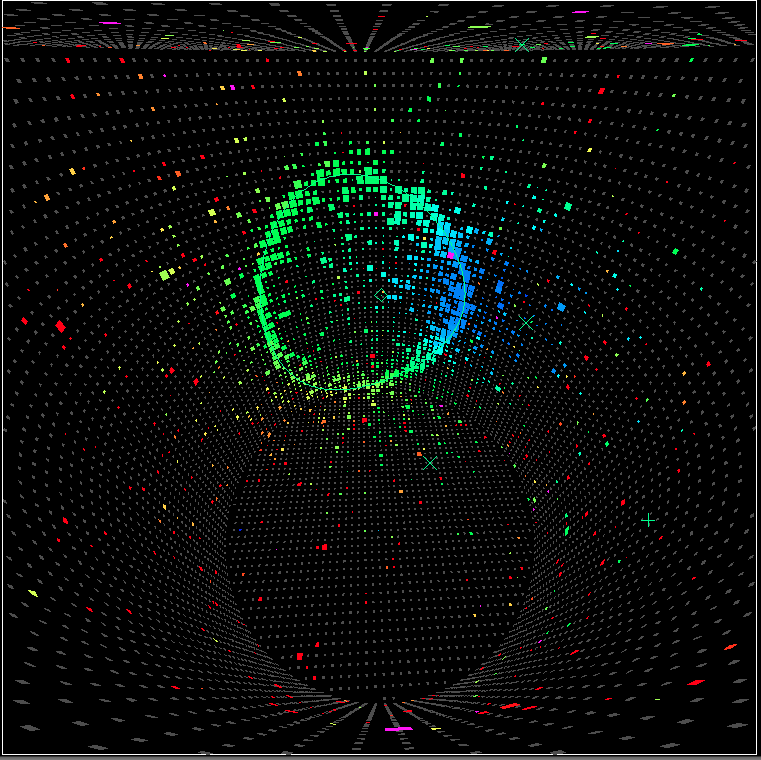
Electron-neutrino candidate in Super Kamiokande
Today at the European Physical Society meeting in Stockholm, the international T2K collaboration announced a definitive observation of muon neutrino to electron neutrino transformation. In 2011, the collaboration announced the first indication of this process, which was then a new type of neutrino oscillation; now, with 3.5 times more data, this transformation is firmly established. The probability that random statistical fluctuations alone would produce the observed excess of electron neutrinos is less than one in a trillion. Equivalently, the new results exclude such a possibility at the 7.5 sigma level of significance. This T2K observation is the first of its kind in that an explicit appearance of a unique flavor of neutrino at a detection point is unequivocally observed from a different flavor of neutrino at its production point.
In the T2K experiment in Japan, a muon-neutrino beam is produced at the Japan Proton Accelerator Research Complex (J-PARC), located in Tokai village, Ibaraki prefecture, on the east coast of Japan. The neutrino beam is monitored by a detector complex in Tokai and aimed at the gigantic Super-Kamiokande underground detector in Kamioka, near the west coast of Japan, 295 km (185 miles) away from Tokai. An analysis of the data from the Super-Kamiokande detector associated with the neutrino beam time from J-PARC reveals that there are more electron neutrinos (a total of 28 events) than would be expected (4.6 events) without this new process.
Neutrino oscillation is a manifestation of a long-range quantum mechanical interference. Observation of this new type of neutrino oscillation leads the way to new studies of charge-parity (CP) violation which provides a distinction between physical processes involving matter and antimatter. This phenomenon has only been observed in quarks (for which Nobel prizes were awarded in 1980 and 2008). CP violation in neutrinos in the very early universe may be the reason that the observable universe today is dominated by matter and no significant antimatter, which is one of the most profound mysteries in science. Now with T2K firmly establishing this form of neutrino oscillation that is sensitive to CP violation, a search for CP violation in neutrinos becomes a major scientific quest in the coming years, and T2K will continue to play a leading role. The T2K experiment expects to collect 10 times more data in the near future, including data with an antineutrino beam for studies of CP violation in neutrinos.
The T2K experiment was constructed and is operated by an international collaboration. The current T2K collaboration consists of over 400 physicists from 59 institutions in 11 countries [Canada, France, Germany, Italy, Japan, Poland, Russia, Switzerland, Spain, UK and US]. The experiment is primarily supported by the Japanese Ministry of Education, Culture, Sports, Science and Technology (MEXT). Additional support is provided by the following funding agencies from participating countries: NSERC, NRC and CFI, Canada; CEA and CNRS/IN2P3, France; DFG, Germany; INFN, Italy; Ministry of Science and Higher Education, Poland; RAS, RFBR and the Ministry of Education and Science of the Russian Federation; MICINN and CPAN, Spain; SNSF and SER, Switzerland; STFC, U.K.; DOE, U.S.A.
This discovery was made possible with the unyielding and tireless effort by the J-PARC staff members and the management to deliver high-quality beam to T2K after the devastating March 2011 earthquake in eastern Japan which caused severe damage to the accelerator complex at J-PARC, and abruptly discontinued the data-taking run of the T2K experiment.
More detailed information on this announcement including some images can be found at http://t2k-experiment.org/supporting-material-for-t2k-press-release-19-7-2013 .
This announcement is also available in Japanese at http://www.kek.jp/ja/NewsRoom/Release/20130719210000/ .
Media Contacts for Further Inquiries:
Globally and in Japan:
Prof. Takashi Kobayashi, Spokesperson, T2K Collaboration, The Institute of Particle and Nuclear Studies, KEK (Tsukuba, Japan), takashi.kobayashi@kek.jp
Phone: +81 90-9840-2413 (c), +81 29-864-5414 (o), +81 29-852-4881 (h)
Globally and in U.S.:
Prof. Chang Kee Jung, International Co-Spokesperson, T2K Collaboration, State University of New York at Stony Brook (Stony Brook, NY, USA) and Kavli IPMU, University of Tokyo (Kashiwa, Japan), chang.jung@stonybrook.edu
Phone: +1 631-707-2018 (c), +1 631-632-8108/8095 (o), +1 631-474-4563 (h)
In Canada:
Prof. Hiro Tanaka, University of British Columbia (Vancouver, Canada), tanaka@phas.ubc.ca
Phone: +1 778-772-3690
In France:
Dr. Jacques Dumarchez, LPNHE-Paris (IN2P3) (Paris, France), jacques.dumarchez@cern.ch
Phone: +33 1 44 27 48 42
Dr. Marco Zito, CEA/IRFU (Saclay, France), marco.zito@cea.fr
Phone: +33 6 84 61 09 51
In Germany:
Prof. Achim Stahl, RWTH Aachen University (Aachen, Germany), stahl@physik.rwth-aachen.de
Phone: +49 241 80 27301 (o), +49 172 5761500 (c)
In Italy:
Dr. Maria Gabriella Catanesi, INFN Sezione di Bari (Bari, Italy), gabriella.catanesi@cern.ch
Phone: +41 764871532
In Poland:
Prof. Ewa Rondio, NCBJ, Warsaw (Warsaw, Poland), Ewa.Rondio@fuw.edu.pl
Phone: +48 691 150 052
In Russia:
Prof. Yuri Kudenko, INR (Moscow, Russia), kudenko@inr.ru
Phone: +7-903-6159125 (c), +7-495-8510184 (o)
In Spain:
Prof. Federico Sanchez, IFAE, Barcelona (Barcelona, Spain), fsanchez@ifae.es
Phone: +34 93 5812835
Prof. Anselmo Cervera, IFIC, Valencia (Valencia, Spain), anselmo.cervera@cern.ch
In Switzerland:
Prof. Andre Rubbia, ETHZ (Zurich, Switzerland), andre.rubbia@cern.ch
Phone: +41 44 633 3873
In Suisse Romande:
Prof. Alain Blondel, Université de Genève, alain.blondel@unige.ch
Phone: +41 76 487 4058
In U.K.:
Prof. Dave Wark, STFC/RAL/Daresbury Laboratory/Oxford University (Oxford, U.K.), david.wark@stfc.ac.uk
Phone: +44 7788186085



